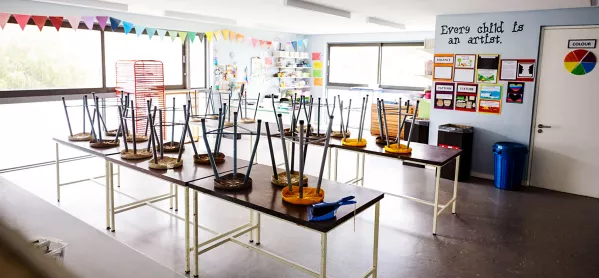- Home
- News
- Early Years
- Converting school space for childcare ‘costs thousands’, DfE told
Converting school space for childcare ‘costs thousands’, DfE told

A pilot scheme exploring how unused school space could be repurposed to offer more childcare places could cost tens of thousands of pounds, a headteachers’ leader has warned.
The warning comes after the government said it would set up a pilot scheme this summer to look at using unused school space to help find around 85,000 new childcare places. It estimates this number will be needed by September 2025 for the expansion of funded childcare for working parents in England.
The NAHT school leaders’ union has warned that the scheme, which is yet to be set up, would need to be fully funded.
The Department for Education said today that, if the pilot is successful, the school space scheme will be rolled out widely ahead of the launch of the final phase of the government’s new childcare offer in September next year.
Using spare school space for childcare
The DfE announcement comes after Labour said last year that it would look at ways to increase the amount of primary school-based nursery provision and develop a plan for the widening of childcare eligibility promised by the Conservatives in the 2023 Budget.
While admitting that there was some logic in repurposing spare classroom space amid falling pupil numbers, James Bowen, assistant general secretary at the NAHT, warned that past experience shows “it does come with a cost”.
“Nurseries need to have outdoor space, their own toilets and food preparation facilities.” he said.
“All these need to be factored in and costed before classrooms can be converted. It’s not unusual for such changes to cost tens of thousands of pounds, if not more, in some cases.”
- Pupil population: Schools face £1 billion funding hit from falling pupil rolls
- DfE: Primary pupil numbers to plummet by 410,000 in five years
- Falling rolls: Barran urges “caution” over school closures
“If the pilot is to be successful, it will need to be fully funded,” Mr Bowen added.
Speaking to Tes after the announcement, Mr Bowen warned that the shortage of early years staff would be another big barrier to the success of the policy, adding that “converting a space is one thing, having the staff to work with the children is another”.
What if pupil numbers rise again?
The DfE said the pilot scheme will involve matching a small number of private, voluntary or independent childcare providers with surplus school and college space. The list of areas that will participate is still being finalised.
Tes understands that the government arm’s-length body LocatED, which finds sites for schools, will engage with local authorities, schools and childcare providers to facilitate repurposing school space to early years provision in these areas once the list is set.
Although pupil numbers are falling, Mr Bowen warned that the government must be “mindful of the longer-term” implications of its plan. The current decline in the primary population could “quickly change and those classrooms could once again be needed”, he said.
Academies minister Baroness Barran echoed this warning in November when she urged “caution” over closing schools in the face of falling pupil numbers.
The number of primary pupils in state-funded schools is projected to drop by more than 410,000 over the next five years, government data published last year shows, with falling pupil numbers already beginning to impact school budgets.
Decline in pupil population hits school budgets
Research published this month suggested that schools could lose £1 billion in per-pupil funding by 2030 because of falling population numbers.
Around half of 143 school-based childcare and early years providers said they were experiencing staffing issues, in a government poll published today.
More than a third said staff decisions to leave were related to work-life balance.
And more than a third said that uncertainty over whether future government funding rates would make additional places worthwhile was a barrier to offering more places.
After the expansion of “free entitlement” funding to parents of children under 3 was announced in the Spring Budget, a third of school-based providers said they were likely to offer more places to children aged under 3 or start offering places to children where this was not currently the case.
For the latest education news and analysis delivered directly to your inbox every weekday morning, sign up to the Tes Daily newsletter
Keep reading for just £1 per month
You've reached your limit of free articles this month. Subscribe for £1 per month for three months and get:
- Unlimited access to all Tes magazine content
- Exclusive subscriber-only stories
- Award-winning email newsletters



